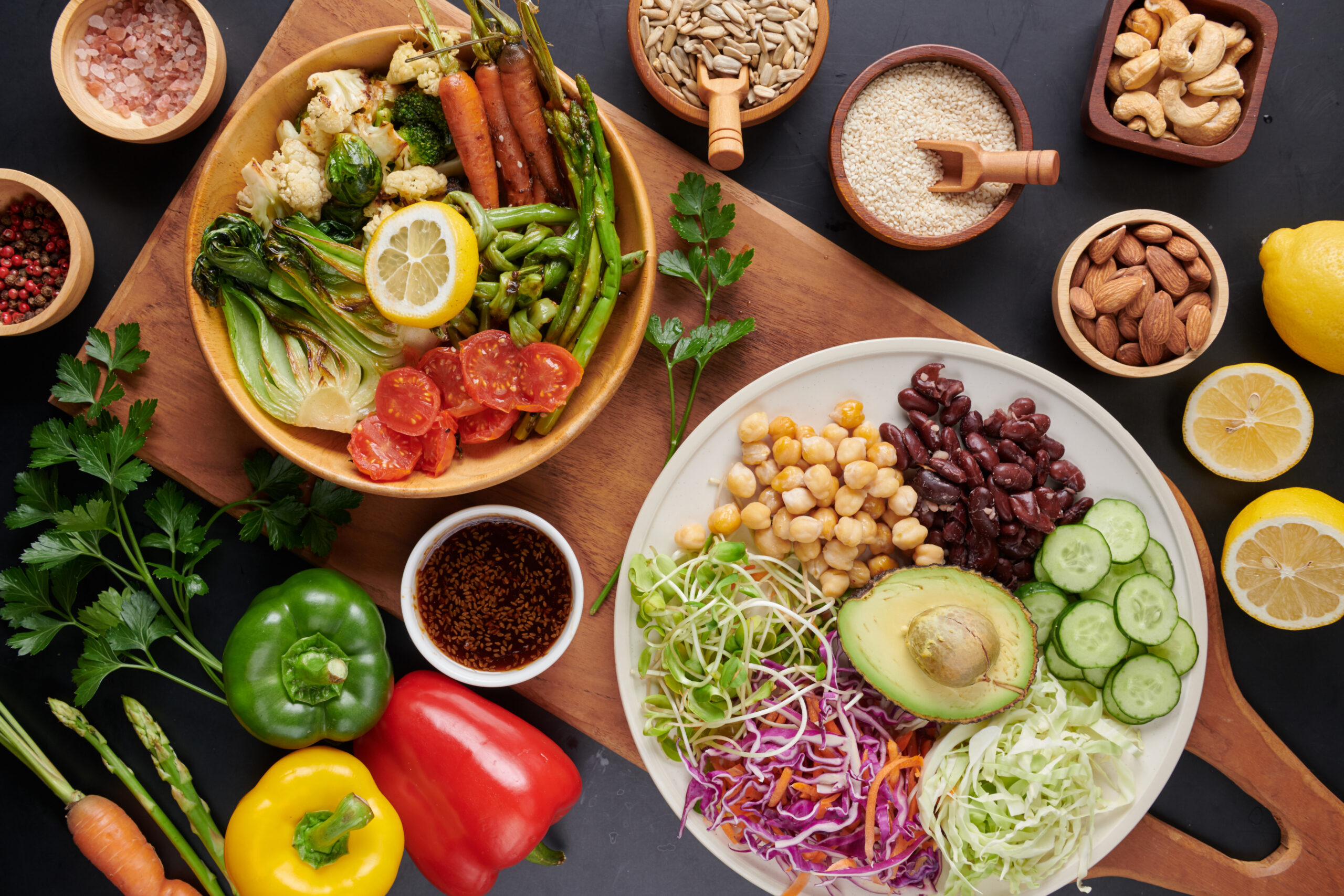
Maximizing Produce Freshness – Plus Bonus Recipe
The dietary guidelines from 2020-25 in the US advise to allocate half of your plate to fruits and vegetables for the optimal healthy meal. Despite this, approximately 90% of Americans fail to meet the daily recommended intake of vegetables, while around 80% fall short on fruit consumption.
With warmer temperatures and the summer fast approaching, fruits and vegetables become abundant, less costly, and with peak flavor. Farmer’s Markets offers an excellent array of delicious, locally-grown produce. Understanding how to handle your fruits and vegetables properly can give you the tools to eat healthier while minimizing food waste.
Safe Handling
Selection: Choose produce that is free from bruises, cuts, or mold. Inspect your produce for signs of damage or spoilage.
Storage: In general, you should store your produce in the same way it was stored at the grocery store. For example, if your asparagus was in the refrigerated section of the store, store it in your refrigerator.
- Always store all cut fruits and vegetables in the refrigerator.
- Regularly inspect your produce for signs of ripening or spoilage and try to use produce with shortest shelf life first.
Follow these helpful storage tips from the Virginia Cooperative Extension Agency:
Pantry Storage: Store the following fruits and vegetables in your pantry
|
|
Fridge Storage: Store the following fruits and vegetables in your refrigerator
|
|
|
|
Washing
Rinse all fruits and vegetables under clean running water just before cutting, cooking, or eating, unless you have pre-packaged produce that says it has already been washed. Even food that you plan to peel before using should be rinsed to prevent bacteria that may be on the outside of the peel from entering the produce once it is cut or peeled.
Handling
As with any food preparation, wash hands with soap and running water for 20 seconds before and after handling produce. Use separate cutting boards, knives, and utensils for produce and raw meat to prevent cross-contamination. Clean preparation surfaces often to reduce the risk of cross-contamination. Cut away any damaged or bruised areas that you may find on your produce.
Maximizing Produce Life
Although fresh produce has a limited shelf life, these few steps can help make it last longer:
- Store your produce properly and promptly as previously outlined.
- Keep your produce clean and dry. Washing produce before storage can lead to excess moisture, which promotes bacterial growth and speeds up spoilage. Ensure produce is dry before storage.
- Be aware that some fruits and vegetables produce a natural gas called ethylene that can speed up ripening and lead to spoilage.
- Do not store fruits and vegetables that produce ethylene with those that are sensitive to it. For example, do not store bananas and apples next to each other. This applies to produce that is refrigerated and not refrigerated.
- Do not store produce in bags or sealed containers. This will trap the gas and cause the produce to ripen faster.
- Ethylene Producers: Apples, Avocados, Bananas, Cantaloupe, Kiwi, Peaches, Pears, Peppers, and Tomatoes
- Ethylene Sensitive: Apples, Asparagus, Avocados, Bananas, Broccoli, Cantaloupe, Collard Greens, Cucumber, Eggplant, Grapes, Honeydew, Kiwi, Lemons, Lettuce, Limes, Mangos, Onions, Peaches, Pears, Peppers, Squash, Sweet Potatoes, Watermelon
Preserving Fresh Produce
- Drying: You can use an oven or food dehydrator to dry produce. This removes about 80-95% of the food’s moisture, making it shelf stable. Fruit can be dried easily in the oven to make fruit leather.
- Canning: This preserves food by killing bacteria with high heat and sealing jars to prevent new bacteria from entering. Hot water bath canning can be used for high acid foods like fruit, pickles, and tomatoes. Pressure canning can be used for low acid foods like mushrooms and vegetables. Proper sterilization of jars, lids, and equipment is essential for food safety in canning.
- Quick pickling: Refrigerator or quick pickles are vegetables marinated in a vinegar-based brine and stored in the refrigerator. It only takes about 15 minutes to prepare and can be used for vegetables like cucumbers, beans, onions, cabbage, and even some fruits.
- Jamming: making jam is an easy and tasty way to preserve an over-abundance of summer fruit. You can make a batch of no cook, low sugar jam in about 30 minutes. Try the recipe below the next time you have excess fruit.
- Freezing: This is a simple way to preserve fresh produce.
- To freeze fruit, wash it and dry before putting in an airtight freezer bag. For fruits like berries and grapes, rinse, dry, then freeze on a baking sheet in a single layer, before transferring to a freezer bag.
- To freeze vegetables, wash and trim first, then blanch in boiling water for a few minutes to help retain their color, texture, and flavor. After blanching, plunge into cold water to stop cooking and then store in freezer bags/containers in the freezer. Onions and peppers do not require blanching.
In summary, learning how to safely handle, store, and preserve fresh produce can help you enjoy the bounty of the season year-round. By embracing these practices, you will unlock the full spectrum of health benefits from fruits and vegetables, while simultaneously saving money and curbing waste. Capitalize on the affordability of local seasonal produce today and leverage the techniques provided here to sustain your enjoyment of delectable, nourishing fruits and vegetables year-round.
Put it to practice with the recipe below!
Strawberry Freezer Jam
adapted from gettystewart.com
Yield: 4 jars
Ingredients
- 6 c strawberries
- 1 ½ c sugar
- 1 pkg Freezer Jam pectin
Instructions
- Wash and clean berries.
- In a shallow baking dish, crush berries, one layer at a time with a potato masher. You should have about 4 c crushed fruit.
- In separate bowl, mix sugar and pectin.
- Add pectin mix to strawberries. Stir until completely dissolved, about 3 minutes.
- Pour into clean jars or plastic freezer containers leaving a ½ inch headspace to allow for expansion.
- Wipe rim with clean cloth and seal.
- Let stand for 30 minutes to set. Then enjoy the tasty jam!
- Keep in fridge for 3 weeks or in freezer for up to a year.
Note: You can also substitute some of the strawberries with other fruits like rhubarb, (3 c strawberries + 1 c stewed rhubarb), blueberries (2 c strawberries + 2 c blueberries, or mangoes (2 c strawberries + 2 c mangoes)



